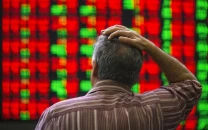Economic recovery and exchange rate
Growing economy in presence of structural weaknesses a challenge for policymakers

The news from the currency market is a regular feature nowadays. The appreciation of the dollar vis-a-vis Pakistani rupee keeps on gathering the attention of people.
Currency analysts and commentators cite various reasons for this volatility and appreciation. Some are of the opinion that the fall of Kabul has propelled the demand for dollar in Pakistan.
Others stress that imports have increased a great deal, which convert the current account surplus into deficit of $2.3 billion for the first two months of fiscal year 2022.
Owing to high uncertainty, importers have started demanding dollars in advance. In addition, high international commodity prices have increased expenditure on imports.
A large number of commentators are of the view that the current account deficit has increased the demand for dollar a great deal and this explanation is in line with the standard economic text.
The press release of Monetary Policy Committee (MPC) of the State Bank of Pakistan (SBP) highlights that Pakistan adopted a flexible exchange rate regime in June 2019 and it has been working well since then.
The exchange rate has supported economic growth and is acting as a shock absorber under external duress. It is stated that the SBP intervenes in the foreign exchange market to address disorderly movement in the market.
Fitch expects rupee to weaken to 180 by 2022
In addition, the SBP has introduced prudential regulations to limit the financing of luxury vehicles. In another move, cash margin requirement has been imposed on certain imported items to curb luxury imports.
These administrative measures take time to yield results while economic agents find ways to bypass them.
On the contrary, critics are of the opinion that the lesson of history is that the flexible exchange rate could not bring fruitful results for developing economies.
In the presence of low foreign exchange reserves, a weak currency comes under speculative attack. Even if foreign exchange reserves are at a comfortable level, these reserves may evaporate in a short span of time.
A credible announcement by the finance minister may play an important role in arresting the decline of the rupee. In the absence of an announcement, speculators sell the currency and may enhance volatility.
The absence of announcement also reflects the deliberate policy of market-determined exchange rate as there is a belief that market forces of demand and supply will help in achieving the equilibrium exchange rate.
The business community has started seeking intervention from the SBP since it becomes difficult for most of the business firms to conduct their operations in a smooth manner.
Many businesses have withheld their orders since the pricing of products and services becomes difficult under the emerging situation. Those firms have adopted a wait-and-see policy as the movement of currency in any direction may distort their forecasts.
In order to grow a developing economy, import demand is fulfilled through the precious foreign exchange reserves. Under the political business cycle, the government intends to grow the economy fast regardless of the balance of payments constraint.
Rupee slides further, touches new all-time low
The growth consumes the reserves in a short span of time, allowing the speculators to manipulate the currency, which in turn increases volatility in the currency market.
Speculators cash in on this volatility and keep on booking profits out of these conditions.
In short, there is a recovery in the real economy, which is accompanied by vulnerabilities in the external sector. Keeping in view the political business cycle, the SBP has responded through a small uptick in the policy rate as it intends to support the current economic recovery.
Growing the real economy in the presence of structural weaknesses will remain a challenge for policymakers in the years to come. Let’s see how things unfold with the new experiment of market-determined exchange rate.
The writer is the Assistant Professor of Economics at SDSB, Lahore University of Management Sciences (LUMS)
Published in The Express Tribune, October 4th, 2021.
Like Business on Facebook, follow @TribuneBiz on Twitter to stay informed and join in the conversation.



















COMMENTS
Comments are moderated and generally will be posted if they are on-topic and not abusive.
For more information, please see our Comments FAQ